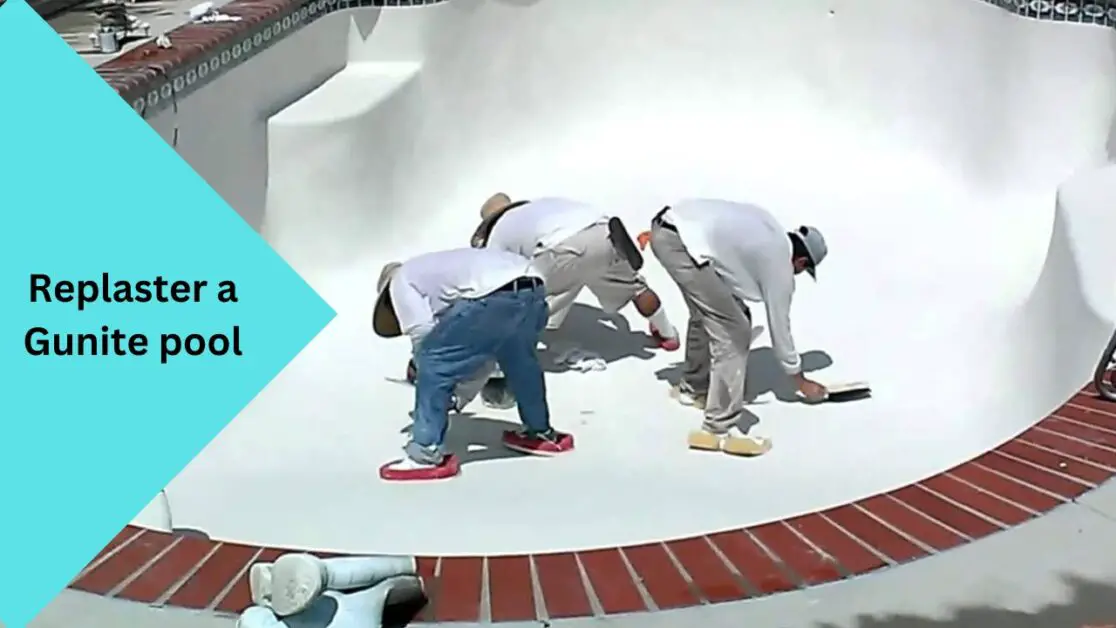Are you a proud owner of a gunite pool? Gunite pools are a popular choice due to their durability and flexibility in design. However, over time, the plaster on the surface of a gunite pool can become worn, chipped, or discolored. If your pool is starting to show signs of wear, you may be wondering, “How much does it cost to replaster a gunite pool?”.
In this comprehensive guide, we will explore the cost factors associated with replastering a gunite pool, how often it should be done, and provide step-by-step instructions on replastering. Additionally, we will address common questions regarding gunite pool repairs and the difference between resurfacing and replastering. So let’s dive in!
- What is Gunite?
- Reasons for Replastering a Gunite Pool
- How Much Does it Cost to Replaster a Gunite Pool?
- How Often Should You Replaster a Gunite Pool?
- The Difference between Resurfacing and Replastering a Pool
- Steps to Replaster a Gunite Pool
- How to Repair Concrete Pool Deck Cracks
- How to Repair a Leaking Gunite Pool
- Life Expectancy of a Gunite Pool
- Do Gunite Pools Need to be Resurfaced?
- Conclusion
What is Gunite?
Before we delve into the replastering process, let’s quickly touch upon what gunite is. Gunite is a mixture of dry cement and sand that is pneumatically sprayed onto a framework of rebar or steel mesh to create the shell of a pool. After the gunite is applied, it is sealed with plaster to provide a smooth and waterproof surface.To explore more details and considerations regarding Gunite pool, our comprehensive guide on What Are Gunite Pools – Unveiling the Wonders has you covered.
Reasons for Replastering a Gunite Pool
Over time, the plaster in a gunite pool can deteriorate due to exposure to chemicals, sunlight, and frequent use. Here are some common signs that indicate the need for replastering:
- Cracked or chipped plaster: As the pool ages, the plaster can develop cracks and chips, which not only affects the pool’s aesthetics but also makes it harder to clean.
- Stains and discoloration: Mineral deposits, algae, and chemical imbalances can cause unsightly stains and discoloration on the pool surface.
- Roughness and peeling: Worn out plaster can feel rough to the touch and may start peeling, potentially causing injuries and hindering your swimming experience.
- Leaks and water loss: If you notice a significant decrease in water level that can’t be attributed to evaporation, it could indicate leaks in the plaster that need to be addressed promptly.
How Much Does it Cost to Replaster a Gunite Pool?
The cost of re plastering a gunite pool can vary depending on several factors. Here are the key aspects to consider when determining the cost:
Factors Affecting the Cost
- Pool Size: The size of your pool is a significant determinant of the overall cost. Larger pools require more materials and labor, hence costing more to replaster.
- Pool Depth and Complexity: Pools with varying depths, intricate designs, or features like vanishing edges or spa areas will have higher costs as they require more expertise and effort to replaster.
- Choice of Plaster: There are different types of plaster available, such as white plaster, colored plaster, or premium finishes like pebble or quartz. Each type has a different price point, with premium finishes being more expensive.
- Local Labor Rates: Labor costs vary from region to region. Higher labor rates may increase the overall cost of replastering.
- Additional Repairs: If your pool requires extensive repairs, rectifying cracks, or fixing leaks before replastering, these additional repair costs should be factored into the overall budget.
Cost Breakdown
- Average Cost Range: $5,000 – $15,000
- White Plaster: $5,000 – $7,000
- Colored Plaster: $6,000 – $8,000
- Premium Finishes (Pebble or Quartz): $9,000 – $15,000
Remember, these figures are averages, and the final cost may vary based on your specific requirements and location. It’s always best to consult with pool professionals and gather multiple quotes to get an accurate estimate.
How Often Should You Replaster a Gunite Pool?
The frequency of replastering your gunite pool depends on multiple factors, including the quality of the initial installation, maintenance practices, and the type of plaster used. On average, a gunite pool should be replastered every 10 to 15 years. However, some factors may necessitate more frequent replastering:
- Poor Water Chemistry: Imbalances in pH levels, high calcium hardness, or inadequate water sanitation can accelerate plaster deterioration, requiring more frequent replastering.
- Harsh Climate: Extreme heat, cold, or freeze-thaw cycles can degrade the plaster at a faster rate, warranting more regular replastering.
- Lack of Maintenance: Neglecting regular pool maintenance, such as brushing and maintaining proper chemical levels, can lead to faster plaster degradation.
It is crucial to monitor the condition of your pool’s plaster regularly and address any signs of damage promptly to ensure its longevity.
The Difference between Resurfacing and Replastering a Pool
Many people often use the terms resurfacing and replastering interchangeably when referring to pool renovations. However, it’s important to understand the distinction between the two:
- Replastering: Replastering involves removing the existing plaster layer and applying a new layer of plaster. It is typically done to restore the pool’s smoothness and appearance.
- Resurfacing: Resurfacing goes beyond replastering and involves more extensive repairs or upgrades. It may include adding a new layer of plaster, as well as other enhancements like pebble finishes, tile work, or new decking material.
The choice between replastering and resurfacing depends on the condition of your pool, budget, and desired outcome. For minor cosmetic issues, replastering may suffice, whereas resurfacing is ideal for pools requiring additional repairs or a complete makeover.
Steps to Replaster a Gunite Pool
If you’re up for the challenge of replastering your gunite pool yourself, here is a step-by-step guide to help you through the process. Keep in mind that replastering can be a labor-intensive task, and it’s crucial to follow proper safety precautions and use appropriate materials.
Step 1: Drain the Pool
Before starting the replastering process, ensure that the pool is completely drained. Follow local regulations and guidelines for proper drainage and disposal of pool water.To explore more details and considerations regarding Draining the pool, our comprehensive guide on How to Drain Last Bit of Water from You’re Pool? has you covered.
Step 2: Prepare the Surface
Clean the pool thoroughly by removing any debris, dirt, or algae. Use a pressure washer to powerfully rinse the gunite surface, ensuring it is free from any loose material or contaminants.
Step 3: Apply the New Plaster
Mix the plaster according to the manufacturer’s instructions, incorporating any required additives or colorants. Apply the first layer of plaster, known as the bond coat, using a trowel. Ensure the bond coat covers the pool surface uniformly.
Step 4: Cure and Finish
Allow the bond coat to cure for the recommended duration. Once cured, apply the final layer of plaster, known as the finish coat. Smooth and level the finish coat using a trowel or pool float. Carefully follow the manufacturer’s instructions for curing time and post-application care.
If you’re uncomfortable with replastering your pool yourself or feel it’s beyond your expertise, it’s best to hire a professional pool contractor for this task.
How to Repair Concrete Pool Deck Cracks
In addition to replastering, you may also encounter cracks in your concrete pool deck. Here is a step-by-step guide to repairing those cracks:
Step 1: Assess the Damage
Inspect the cracks to determine their width and depth. Small surface cracks can usually be repaired using specialized sealants, while larger or structural cracks may require professional attention.
Step 2: Clean and Prep the Area
Thoroughly clean the cracked area, removing any debris or loose material. Use a wire brush followed by a pressure washer to ensure a clean and sound surface for repair.
Step 3: Fill the Cracks
Select a suitable concrete crack filler or sealant and apply it according to the manufacturer’s instructions. Use a putty knife or trowel to push the filler into the cracks, ensuring a level surface.
Step 4: Smooth and Finish
Once the filler has cured, lightly sand or smoothen the surface to achieve a seamless finish. You may opt to coat the repaired area with a concrete sealer to enhance its durability and appearance.
For complex or structural cracks, it is recommended to consult a professional concrete contractor who specializes in pool deck repairs.
How to Repair a Leaking Gunite Pool
Dealing with a leaking gunite pool can be a cause for concern. Here are the steps to repair a leak:
Step 1: Identify the Source of Leak
Thoroughly inspect the pool and its equipment to identify the exact location of the leak. Common sources of leaks include plumbing fittings, skimmers, or cracks in the gunite.
Step 2: Drain the Pool
In order to repair the leak, the pool may need to be drained. Follow the necessary safety protocols for draining and consider consulting a professional if you are unsure about the process.
Step 3: Repair the Leak
Depending on the source of the leak, different repair methods may be required. For minor leaks, specialized epoxy or underwater patching materials can be utilized. More significant leaks may require professional assistance to ensure proper repair.
Always remember to conduct regular pool maintenance and address any signs of leaks promptly to avoid further damage.
Life Expectancy of a Gunite Pool
One of the advantages of gunite pools is their long lifespan. With proper maintenance and care, a well-constructed gunite pool can last for 30 to 50 years or more. Regular cleaning, maintenance of water chemistry, and addressing repairs promptly are essential to extend the life expectancy of your gunite pool.To explore more details and considerations regarding Guite pool life, our comprehensive guide on How Long Do Gunite Pools Really Last? Unveiling the Truth. has you covered.
Do Gunite Pools Need to be Resurfaced?
Gunite pools do not necessarily need to be resurfaced with new plaster unless there are significant cosmetic or structural issues. Replastering at the appropriate intervals and ensuring regular maintenance can keep your gunite pool in excellent condition without the need for resurfacing.
Conclusion
Replastering a gunite pool is an essential part of its maintenance and ensures its longevity, aesthetics, and functionality. By understanding the cost factors, frequency, and steps involved, you can make an informed decision about replastering your pool or seeking professional help.
Remember, proper maintenance, regular inspections, and prompt repairs are key to extending the life of your gunite pool. Whether you choose to replaster, resurface, or repair a leaking pool, always consult with experts in pool renovation and maintenance to ensure the best results.
Now that you’re equipped with all the essential information about replastering your gunite pool, it’s time to dive into the process and give your pool a refreshing facelift!

Greetings, fellow pool enthusiasts! I’m Turner Davis, your dedicated guide to the world of pool care and maintenance. With over a decade of experience in the field, I’ve made it my mission to transform ordinary pools into extraordinary aquatic retreats.

